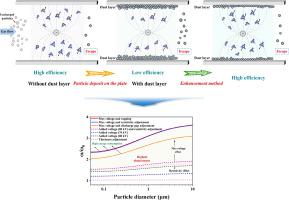当前位置:
X-MOL 学术
›
Fuel Process. Technol.
›
论文详情
Our official English website, www.x-mol.net, welcomes your feedback! (Note: you will need to create a separate account there.)
Minimizing the adverse effects of dust layer on the particle migration in electrostatic precipitator under various temperature
Fuel Processing Technology ( IF 7.5 ) Pub Date : 2021-03-01 , DOI: 10.1016/j.fuproc.2020.106659 Hao Zhang , Yifan Wang , Wenchao Gao , Zhicheng Wu , Zhengda Yang , Yang Yang , Weihong Wu , Chenghang Zheng , Xiang Gao
Fuel Processing Technology ( IF 7.5 ) Pub Date : 2021-03-01 , DOI: 10.1016/j.fuproc.2020.106659 Hao Zhang , Yifan Wang , Wenchao Gao , Zhicheng Wu , Zhengda Yang , Yang Yang , Weihong Wu , Chenghang Zheng , Xiang Gao

|
Abstract The dust layer formed by charged particle deposition severely limited efficient and stable applications of electrostatic precipitators (ESPs). In this work, a modified method was established to study impacts of dust layer on space electric strength, particle charging and migration regarding various temperature. Results indicated that space electric strength declined as dust layer thickness and resistivity increased especially under high temperature, but resistivity was the main influencing factor. When resistivity increased form 1 × 109 to 7 × 1011 Ω·cm, space electric strength reduced by more than 40% at 723 K. Besides, under low resistivity, high temperature improved diffusion charging to strengthen particle charging ability in entire diameter range especially for small particle, whereas field charge was suppressed with temperature increased under high resistivity, contributing to reduction of large particle charges. Furthermore, the role of dust layer in particle migration at different temperature was discussed. Migration velocity rapidly reduced under high resistivity and temperature, which decline rates were 61.8% at 723 K and 36.5% at 323 K as resistivity increased from 1 × 109 to 7 × 1011 Ω·cm. Criterions for migration velocity deterioration of various particle size under various temperature and strategies for reducing the adverse influence of dust layer were obtained.
中文翻译:

尽量减少不同温度下尘层对静电除尘器中颗粒迁移的不利影响
摘要 带电粒子沉积形成的粉尘层严重限制了静电除尘器(ESPs)的高效稳定应用。在这项工作中,建立了一种改进的方法来研究不同温度下灰尘层对空间电气强度、粒子充电和迁移的影响。结果表明,空间电气强度随着灰尘层厚度和电阻率的增加而下降,尤其是在高温下,但电阻率是主要影响因素。当电阻率从 1 × 109 增加到 7 × 1011 Ω·cm 时,空间电气强度在 723 K 时降低了 40% 以上。此外,在低电阻率下,高温改善了扩散充电,增强了颗粒在整个直径范围内的充电能力,特别是对于小颗粒,而在高电阻率下,场电荷随着温度的升高而受到抑制,有助于减少大颗粒电荷。此外,还讨论了灰尘层在不同温度下颗粒迁移中的作用。迁移速度在高电阻率和温度下迅速降低,随着电阻率从1×109增加到7×1011 Ω·cm,迁移速度在723 K时下降率为61.8%,在323 K时下降率为36.5%。得到了不同温度下不同粒径迁移速度劣化的判据和降低粉尘层不利影响的策略。随着电阻率从 1 × 109 增加到 7 × 1011 Ω·cm,其下降率在 723 K 时为 61.8%,在 323 K 时为 36.5%。得到了不同温度下不同粒径迁移速度劣化的判据和降低粉尘层不利影响的策略。随着电阻率从 1 × 109 增加到 7 × 1011 Ω·cm,其下降率在 723 K 时为 61.8%,在 323 K 时为 36.5%。得到了不同温度下不同粒径迁移速度劣化的判据和降低粉尘层不利影响的策略。
更新日期:2021-03-01
中文翻译:

尽量减少不同温度下尘层对静电除尘器中颗粒迁移的不利影响
摘要 带电粒子沉积形成的粉尘层严重限制了静电除尘器(ESPs)的高效稳定应用。在这项工作中,建立了一种改进的方法来研究不同温度下灰尘层对空间电气强度、粒子充电和迁移的影响。结果表明,空间电气强度随着灰尘层厚度和电阻率的增加而下降,尤其是在高温下,但电阻率是主要影响因素。当电阻率从 1 × 109 增加到 7 × 1011 Ω·cm 时,空间电气强度在 723 K 时降低了 40% 以上。此外,在低电阻率下,高温改善了扩散充电,增强了颗粒在整个直径范围内的充电能力,特别是对于小颗粒,而在高电阻率下,场电荷随着温度的升高而受到抑制,有助于减少大颗粒电荷。此外,还讨论了灰尘层在不同温度下颗粒迁移中的作用。迁移速度在高电阻率和温度下迅速降低,随着电阻率从1×109增加到7×1011 Ω·cm,迁移速度在723 K时下降率为61.8%,在323 K时下降率为36.5%。得到了不同温度下不同粒径迁移速度劣化的判据和降低粉尘层不利影响的策略。随着电阻率从 1 × 109 增加到 7 × 1011 Ω·cm,其下降率在 723 K 时为 61.8%,在 323 K 时为 36.5%。得到了不同温度下不同粒径迁移速度劣化的判据和降低粉尘层不利影响的策略。随着电阻率从 1 × 109 增加到 7 × 1011 Ω·cm,其下降率在 723 K 时为 61.8%,在 323 K 时为 36.5%。得到了不同温度下不同粒径迁移速度劣化的判据和降低粉尘层不利影响的策略。



























 京公网安备 11010802027423号
京公网安备 11010802027423号